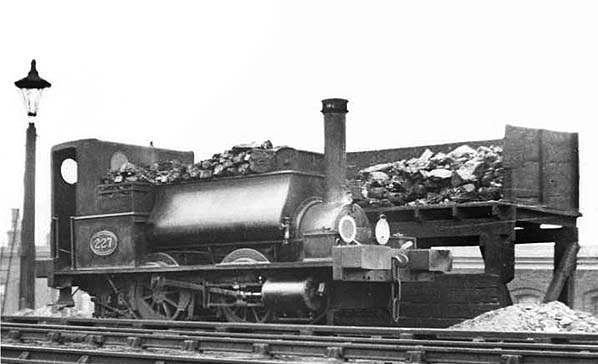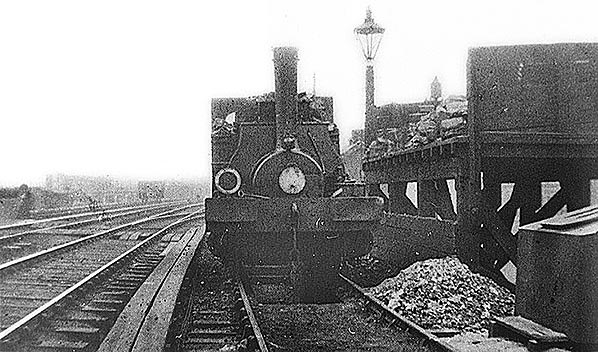
Station Name: GLOBE ROAD & DEVONSHIRE STREET[Source: Nick Catford]
 GER 209 class No.227 stands at the Devonshire Street coal stage, with ash pile on the right, in the early 20th century. There were eight of these diminutive locomotives, nicknamed 'Coffee Pots' and those which survived into LNER days becoming Class Y5. Originally a standard Neilson 0-4-0ST with open cabs, the first two, Nos.209 and 210 were purchased 'off the shelf' in 1874/5. Their purpose was shunting at Devonshire Street and the Pepper Warehouses at Blackwall (accessed from Canning Town and often referred to as such). Two further examples were acquired from Neilson in 1876 for pilot work at Liverpool Street. Sometime during the last decade of the 19th century. Holden rebuilt all four into the form seen above but less obvious were new boilers and the fitting of steam brakes. In 1897 Holden decided more were required and two were built at Stratford that year, with a further two appearing in 1903 and apart from having higher bunkers beside the firebox were identical to the earlier rebuilds. At some point in time most, if not all, were fitted with spark arrestors apparently for use on Hythe Quay, Colchester, but as far as is known only No.231 worked at this location. She was fitted with cowcatchers, side skirts and had a bell perched on her cab roof. Three of the class were given Westinghouse air brake equipment and vacuum ejectors, Nos.228/9/30, for the purpose of testing brakes on new or overhauled coaching stock. However, the first so-fitted was No.229 and when this was withdrawn and sold sometime around 1918 the equipment was removed and fitted to No.230. Other withdrawals occurred as early as 1911, Nos.226 and 227 (in August and December respectively), so this photograph is indeed a rarity. Just one example survived to see British Railways, this being No.230; LNER No.7230 and in 1946 No.8081. She was to become BR No.68081 but was withdrawn in April 1948 without being renumbered. Of No.229, she was sold to a shipyard at Chepstow where she remained until the late 1950s and she is now preserved. The coaling stage seen in this view was located at the west end of Devonshire Street goods yard on the edge of the embankment and on the south side of the main line. The stage was abolished circa 1957 when diesel shunters took over. The GER headcode system was complicated and the meaning of that seen on No.227 is not known. However, it is not thought to be a pilot headcode so may imply a trip working of some sort and perhaps something as simple as tripping wagons between Devonshire Street's north and south sides which would have involved encroaching onto the main line. One might be forgiven for assuming the lamp on the left was lit by oil or gas but in fact it is electric and a switch or junction box can be seen towards the bottom of the standard. Globe Road & Devonshire Street was one of several locations in the area fitted with electric lighting with power supplied by Stratford's generating plant. This stage of the work was completed in November 1907, thus we can date this photograph to sometime between then and December 1911. GER 209 class No.227 stands at the Devonshire Street coal stage, with ash pile on the right, in the early 20th century. There were eight of these diminutive locomotives, nicknamed 'Coffee Pots' and those which survived into LNER days becoming Class Y5. Originally a standard Neilson 0-4-0ST with open cabs, the first two, Nos.209 and 210 were purchased 'off the shelf' in 1874/5. Their purpose was shunting at Devonshire Street and the Pepper Warehouses at Blackwall (accessed from Canning Town and often referred to as such). Two further examples were acquired from Neilson in 1876 for pilot work at Liverpool Street. Sometime during the last decade of the 19th century. Holden rebuilt all four into the form seen above but less obvious were new boilers and the fitting of steam brakes. In 1897 Holden decided more were required and two were built at Stratford that year, with a further two appearing in 1903 and apart from having higher bunkers beside the firebox were identical to the earlier rebuilds. At some point in time most, if not all, were fitted with spark arrestors apparently for use on Hythe Quay, Colchester, but as far as is known only No.231 worked at this location. She was fitted with cowcatchers, side skirts and had a bell perched on her cab roof. Three of the class were given Westinghouse air brake equipment and vacuum ejectors, Nos.228/9/30, for the purpose of testing brakes on new or overhauled coaching stock. However, the first so-fitted was No.229 and when this was withdrawn and sold sometime around 1918 the equipment was removed and fitted to No.230. Other withdrawals occurred as early as 1911, Nos.226 and 227 (in August and December respectively), so this photograph is indeed a rarity. Just one example survived to see British Railways, this being No.230; LNER No.7230 and in 1946 No.8081. She was to become BR No.68081 but was withdrawn in April 1948 without being renumbered. Of No.229, she was sold to a shipyard at Chepstow where she remained until the late 1950s and she is now preserved. The coaling stage seen in this view was located at the west end of Devonshire Street goods yard on the edge of the embankment and on the south side of the main line. The stage was abolished circa 1957 when diesel shunters took over. The GER headcode system was complicated and the meaning of that seen on No.227 is not known. However, it is not thought to be a pilot headcode so may imply a trip working of some sort and perhaps something as simple as tripping wagons between Devonshire Street's north and south sides which would have involved encroaching onto the main line. One might be forgiven for assuming the lamp on the left was lit by oil or gas but in fact it is electric and a switch or junction box can be seen towards the bottom of the standard. Globe Road & Devonshire Street was one of several locations in the area fitted with electric lighting with power supplied by Stratford's generating plant. This stage of the work was completed in November 1907, thus we can date this photograph to sometime between then and December 1911.Photo from James Lake collection  This is not the same locomotive as seen in the view of No.227 as the example seen here still retains the earlier style of coal bunker. Nevertheless it is the same location as the photograph of No.227 and taken around the same time. The station avoiding lines can be seen on the left, so this view is looking east. The rectangular box behind the locomotive's chimney is a tool box. On the three class members which received Westinghouse brakes, the toolbox was moved further back and an air reservoir fitted directly behind the chimney. The Westinghouse pump was fitted on the righthand side of the smokebox when viewed from the front.
Photo from Roger Griffiths collection
|
 Home Page
Home Page